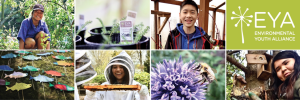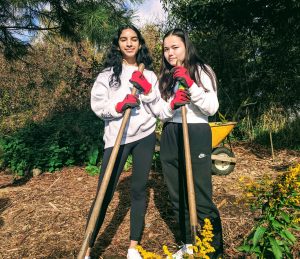This blog post is written by Tamara Rahmani, Western Canada Charity Engagement Specialist at CanadaHelps.
To celebrate Earth Day 2020, we connected with Environmental Youth Alliance (EYA), a charity inspiring young environmental leaders in Metro Vancouver through unique nature experiences in urban spaces. We sat down (just before social isolation) with the Philanthropy Officer, David Palmer to fill us in on their role in their community.

CanadaHelps: Tell me how the Environmental Youth Alliance came to be?
David: EYA was founded in 1989 by a high school student named Jeffery Gibbs in Vancouver. It was Canada’s first youth-led environmental organization and it grew out of a network of high school environmental clubs. Since the early 90s, we’ve empowered tens of thousands of youth facing barriers through experiential nature-based education, employment and skills training, and environmental conservation initiatives in urban green spaces in Vancouver. Youth have created dozens of community gardens and rewilding spaces across the city that provide habitat for birds and pollinators.
Our main programming site is in Strathcona Community Gardens which has a youth-run native plant nursery on the edge of Vancouver’s Downtown Eastside. It was once a garbage dump but today it’s a really important ecologically and socially diverse space — the only biodiverse green space in an otherwise highly-paved neighbourhood.
CanadaHelps: Who is participating in your programs?
David: We focus on providing opportunities for youth facing barriers and that includes urban Indigenous youth, recent immigrant youth and youth impacted by poverty in the city.
We help them by developing skills in horticulture, ecology and conservation, connecting with the community and using nature to cultivate resilience. Nature is an incredible tool for supporting youths’ mental and physical health. Through environmental stewardship youth with limited access to nature are able to develop a love and concern for nature and learn to steward the environment for future generations.
Each year we support over 750 youth who grow thousands of native plants like ferns, Yarrow, Lupins, Red Columbine and Salal that create habitat for birds, bees and other wildlife in the city. Youth also learn about the different uses of native plants by Indigenous people for food, medicine, and ceremony. Overall our goal is to provide opportunities for urban youth to connect with nature in a meaningful way and become stewards of the land, working with nature to provide a space where we can all thrive together in the city; human, animals, birds, insects, plants.

CanadaHelps: What is your impact on the youth?
David: There is definitely a lack of opportunities like this, particularly for urban youth and particularly for youth impacted by poverty that don’t have the same opportunities to access nature. Vancouver is often perceived as a nature-loving city as we are surrounded by mountains and oceans. But if you’re a youth facing barriers to getting out of the city and living in a neighbourhood like the Downtown Eastside, nature isn’t as accessible to you.
Youth tell us that learning about nature in the city made them appreciate life more, made them want to go outside more and identify plants and birds. They say it’s helped with their focus at school and helped with anxiety. For the Indigenous youth we work with its reconnecting with the land and ancestral traditions that’s so important, meeting Elders and knowledge Keepers in the community.
CanadaHelps: What are some examples of barriers the youth face?
David: Barriers include mental health, impacts of colonization, intergenerational trauma, and just not having the opportunity to be introduced to nature and what it can offer. Many of the youth who come into our programs haven’t spent any meaningful time in nature. Youth often spend a lot of time indoors, time on their cell phones, and that’s been linked to rising depression and anxiety amongst youth and social isolation as well. So getting youth outside, connecting them with nature and community is really important for mental health. Once they’ve been through the program it just opens up a whole world for them.
CanadaHelps: What are the environmental barriers in Vancouver?
David: If you use tree canopy cover as a general indicator of the amount of biodiversity in a neighbourhood, Strathcona (where EYA’s inner-city programming site is located) has only 6 percent tree cover. Whereas if you compare that to the wealthier West Side of Vancouver it goes up to about 29 percent. And a lot of that is in private gardens.
This is one of the many ways where environmental justice and social justice intersect. There’s a lot of research that shows how important nature connection is for mental health, wellbeing and outlook and there’s a lot of inequality to accessing nature, and even in the environmental movement itself which is often dominated by white, more affluent perspectives.
CanadaHelps: Why is environmental stewardship important?
David: Maintaining balance is important and we have a responsibility to restore balance in our ecosystems. The number of birds and pollinators in urban areas have been steadily declining for a long time and we know biodiverse green spaces are essential for soil health, local food systems and a healthy, livable city.
I think learning to work in union with nature is important. When youth restore habitat and grow plants they’re developing a positive, reciprocal relationship with nature and taking on a caregiving responsibility for the land that sustains us all.
CanadaHelps: Has the global rise in environmental strikes had an impact on EYA?
David: There has been increased awareness and support for the environment which has been steadily increasing for years, but particularly the last couple of years. So yes, I would say so- it has been really encouraging. It’s enabled us to grow our community of supporters which means we can connect more youth to nature and equip them with the hands-on stewardship skills to directly impact the environment.
The recent Climate Strike protests have been really important for giving youth a voice and putting the climate crisis at the forefront of public and political discourse.
Leave a Reply